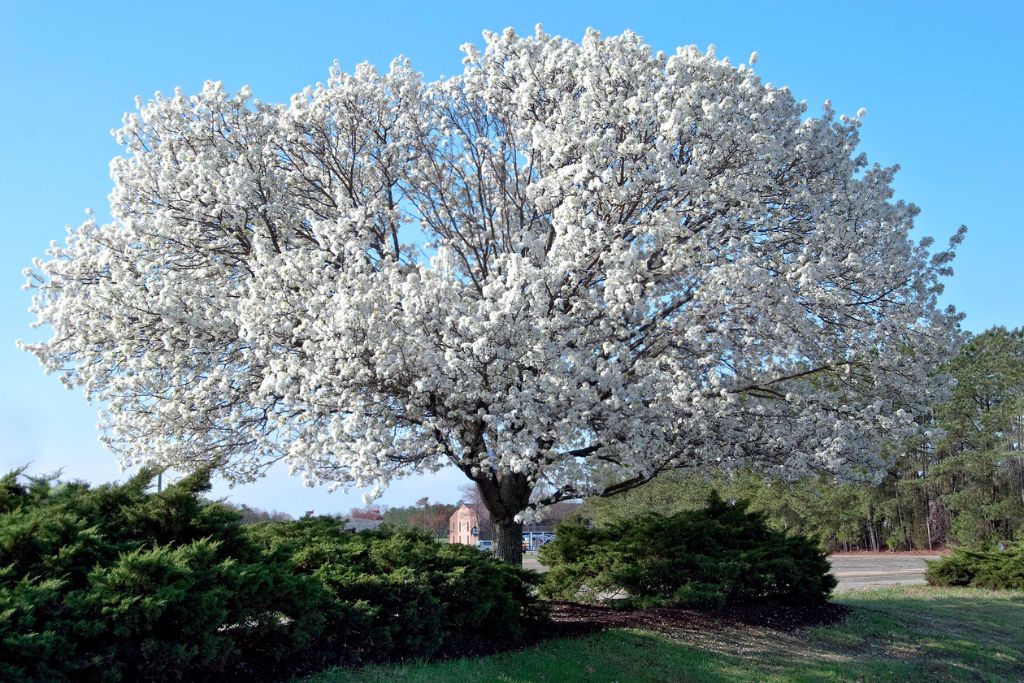Blog, Tree Identification
Tree Of The Month: The Flowering Dogwood
Welcome to our new monthly feature, the Tree of the Month. Each month we’ll provide readers with an in-depth look at a select species of tree. The focus of the Tree of the Month feature will be on trees native to the Midwest or that will thrive in area soil and weather conditions. 
Our goal is to help our customers and readers learn more about their trees, proper care of their trees and to make them aware of tree species they may want to consider adding to the landscaping of their property.
Our first Tree of the Month is, appropriately, the official tree of the State of Missouri, the flowering dogwood. Designated the official state tree in 1955, the flowering dogwood is a familiar site in the St. Louis area, as well as throughout much of the state, as well as in the eastern U.S.
Dogwoods rarely exceed 40 feet in height, with trunks usually of less than 18 inches in diameter.
What Makes The Flowering Dogwood Special?
The flowering dogwood is especially known for, appropriately enough for its flowering cycle. This begins with the sprouting of tiny green-yellow flowers in tight clusters, with each flower being surrounded by (usually) four large, brilliant white petal-like bracts. These turn orange or scarlet in the fall, with silvery “hairs” beneath them. In addition, small, bright red fruits grow seasonally on dogwoods.
Dogwoods are also known for their full shape. While not a tree or a species that features the extended horizonal limbs of an elm tree, for example, dogwoods typically have a dense network of branches, giving the mature trees a rounded, healthy appearance.
What Environment Do Dogwoods Like?
While dogwoods tend to be somewhat hardy trees, they require moist soil and do not survive in arid environments. However, with proper irrigation dogwoods can and do successfully grow in hot, dry areas.
On the opposite end of the climate spectrum, dogwoods generally do not thrive in soil that is routinely saturated from excessive flooding or irrigation.
Still, dogwoods are often found growing well along creek or riverbanks.
Do Dogwoods Require Special Care?
It’s not uncommon for dogwoods to grow multiple trunks, with the trunks separating just a few feet above the ground. This, combined with their dense branch systems, can place significant stress on the junction of the joints. This makes dogwoods susceptible to splitting during heavy windstorms.
Because of this, having your dogwood trees examined by a certified arborist can identify any risky structures in the trees. Trees that are deemed to be at risk for suffering from heavy damage from wind can then be pruned, cabled or braced to lessen the likelihood of damage.
Can Dogwoods Be Planted Successfully?
Dogwoods can be planted as young saplings and grow well, especially when planted in spring. The keys to planting dogwoods are first, selecting an appropriate site with ample water, but not in a saturated area. Dogwoods also like partial sun, preferring shade to intense sun. Second, it’s important to dig a hole significantly wider than the sapling’s root system – two to three times as wide – and prep it with a 50/50 mix of soil and either compost or organic matter. Soaking the root system for several hours prior to planting is a good idea.
Plant the tree with its uppermost root system partially exposed. Spread mulch around but not on top of the exposed roots and mound the mulch to divert water ono the root ball. Finally, remember dogwoods grow best in moist soil, so watering every week or two during dry periods will help them become established.
If you are uncertain as to whether dogwoods are well-suited to your property, or if you need direction on how, where and when to plant dogwoods or other species of trees, contact us today and make an appointment with one of our certified arborists.
Contact us today!
